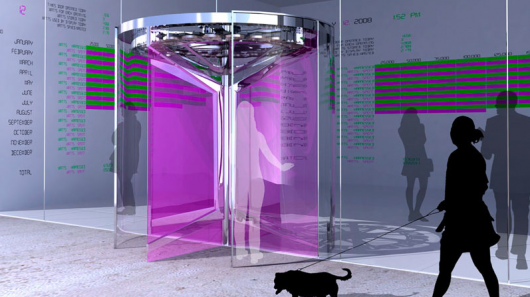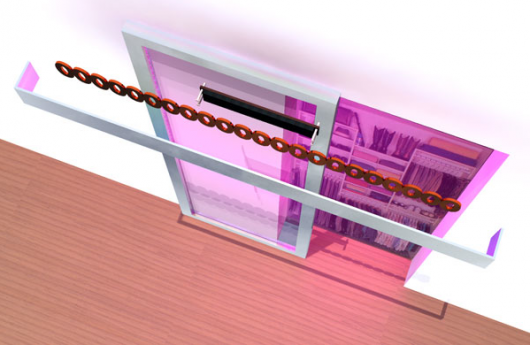FLUXXlab shows us how we're part of the energy cycle
By Ben Coxworth
20:59 March 18, 2010

Here’s how the natural energy cycle works: the sun creates energy when it causes the plants to grow, the plants create energy when they’re eaten by animals, the animals and the plants create energy when they’re consumed by people, and then the people create energy when they do things like open doors. That’s sort of the idea, anyway, and it’s one that New York architectural designers Carmen Trudell and Jenny Broutin have tried to express through their design firm, FLUXXlab. They have created several clever devices designed to convert human energy into electricity, and to educate people on their place within the energy cycle.

The Revolution Door
FLUXXlab’s most talked-about concept is without a doubt their energy-harvesting revolving door. Called the Revolution Door, it will consist of lightweight door panels joined to a central core, which is attached at the top to a circular wire coil array, a rotating magnet array, and a gear/flywheel assembly. When people push on the door panels as they go in or out of the building, the gears will amplify the spinning motion, the flywheel will smooth it out, and the arrays will convert it to electricity. The inner workings will be visible via a glass enclosure, and the door’s power output will be displayed on an electronic wall display, so users will be aware of both how they’re generating electricity, and how much they’re generating. New York University has provided a grant to get a prototype Revolution Door installed on its campus.

The Door Dynamo
A simpler device, designed for use on regular, non-revolving doors, preceded the Revolution Door. The Door Dynamo, as it’s called, combines a hand-crank flashlight dynamo with an automatic door closer to convert kinetic door-opening/closing energy into electricity. The device was used in a study at Columbia University’s Lerner Hall cafeteria, where the amount of energy harvested by the Door Dynamo was compared to the amount of calories consumed and spent by its users.

The Powerslide
Similar to the Door Dynamo, the Powerslide converts the sliding motion of things like windows, drawers and sliding doors into electricity, via an alternator.
Depending on how busy the building is, the amounts of electricity generated by the Door Dynamo and Powerslide might be relatively negligible. Both of these items, however, were designed as much to educate people as to power their buildings - as it says on the FLUXXlab website, regarding the Revolution Door, “[it] will directly communicate a single person's contribution to an energy cycle possible through the metabolic relationship between people, technology, and architecture.”
For another example of a power-generating revolving door, check out the one developed two years ago by Dutch door manufacturer Royal Boon Edam.
Copyright © gizmag 2003 - 2010 To subscribe or visit go to: http://www.gizmag.com